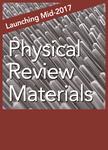版权所有:内蒙古大学图书馆 技术提供:维普资讯• 智图
内蒙古自治区呼和浩特市赛罕区大学西街235号 邮编: 010021

作者机构:Department of Materials Science and Engineering University of California Los Angeles California USA Department of Mechanical and Aerospace Engineering University of California Los Angeles California USA
出 版 物:《Physical Review Materials》 (Physic. Rev. Mat.)
年 卷 期:2024年第8卷第11期
页 面:113603-113603页
核心收录:
基 金:U.S. Department of Energy, USDOE PPG Inc Office of Science at Argonne National Laboratory U.S. DOE Office of Science's Advanced Scientific Computing Research Program, (DE-AC02-06CH11357)
主 题:Adhesion Interface & surface thermodynamics Surface & interfacial phenomena Solid-solid interfaces Density functional theory
摘 要:Aluminum s light weight and high strength make it highly desirable as a structural material in the transportation sector. However, its relatively high corrosion susceptibility poses challenges for its wide application under exposure to the elements. Traditionally, hexavalent chromium (VI) oxide (CrO3) coatings have been employed to provide corrosion protection, but their toxicity and environmental impact have motivated research to seek less harmful options. Trivalent chromium (III) oxide (Cr2O3) suggests itself as a natural alternative due to its similar chemistry and lower toxicity. However, the stability of its bonding to pure Al metal substrates has not been thoroughly investigated. This study focuses on calculations of the adhesion work (Wad) and interface energy (γij) of Al/CrO3 and Al/Cr2O3 interface structures with different Al crystallographic orientations ((100), (110), and (111)) using density functional theory calculations. Significant variations in the adhesion work Wad and interface energy γij were observed for Al/CrO3 interface structures across different Al planes, primarily attributed to the formation of interpenetrating Al-Cr oxide substructures and the formation of Al-O-Al bonds within the interface region. In contrast, the Al/Cr2O3 interface energies exhibited a relatively weak dependence on the metal substrate orientation, with well-defined oxide and metallic layers and no oxygen penetration into the aluminum. Notably, Al/Cr2O3 interfaces generally displayed higher adhesion work Wad and lower interface energy γij compared to Al/CrO3, suggesting that Cr2O3 forms more stable interfaces and adheres more strongly to Al. These findings contribute to the development of sustainable corrosion protection solutions in the aerospace and marine industries by highlighting the potential of Cr2O3 coatings as a viable environmentally friendly alternative to CrO3.